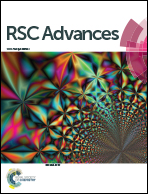Optimization of ionic liquid based dispersive liquid–liquid microextraction combined with dispersive micro-solid phase extraction for the spectrofluorimetric determination of sulfasalazine in aqueous samples by response surface methodology†
Abstract
A new method for the rapid analysis of sulfasalazine (SSZ) in aqueous solutions is described by combination of ionic liquid based dispersive liquid–liquid microextraction (DLLME) and dispersive micro solid-phase extraction (D-μ-SPE). In the DLLME step, a symmetrical hydrophobic ionic liquid, 1,3-butylimidazolium hexafluorophosphate ([Bbim][PF6]), with strong fluorescence properties was used as an extractant without using additional chemical reagents to extract SSZ from the sample solution. In the D-μ-SPE approach, a dispersed small amount of magnetic nanoparticles (MNPs) was used to retrieve the IL containing SSZ and complete phase separation. After dual micro extraction, the analyte was desorbed with an acetonitrile/ammonia (95 : 5; v/v) solution and the fluorescence intensity of the resulting solution was measured at 356 nm when excited at 285 nm. The concentration of SSZ was determined through the difference in fluorescence signal in the absence and presence of SSZ. The selected variables were screened by fractional factorial design. The significant variables which affected the extraction efficiency of the two extraction processes were optimized using response surface methodology (RSM). As a result, optimal conditions for the extraction efficiency of SSZ were obtained as: sample pH, 9; volume of [Bbim][PF6], 53 μL; amount of sorbent, 40 mg; sonication time, 4.5 min; and desorption time, 2 min. Under the optimal conditions, the calibration curve was linear in the concentration range of 0.12–25.0 μmol L−1 of SSZ. The relative standard deviation (RSD%) for four replicate determinations of 5 μmol L−1 SSZ, limit of detection (LOD) and limit of quantification (LOQ) were 3.2%, 0.056 μmol L−1 and 0.158 μmol L−1, respectively. The recoveries of the various samples spiked with different concentration levels of SSZ were in the range of 88.0–105.9%. Accuracy of the method was evaluated by the analysis of SSZ in tap water, milk, honey and plasma samples.


 Please wait while we load your content...
Please wait while we load your content...